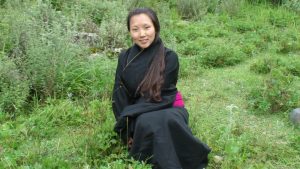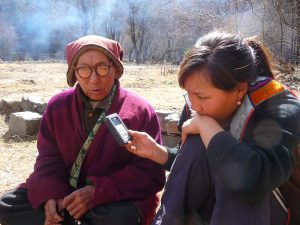Posts under tag: fieldwork
Student Spotlight: Yu Lha (གཡུ་ལྷ།)
Today we hear from Yu Lha, a current undergraduate student who is working on completing a B.A. in linguistics.
In the introduction to your book, you mention the different names that you have gone by: G.yu Lha; Yi Na; Yina; Jody; Yu Lha. Can you speak a bit about that? What are the naming conventions that led to each of those?
I have many names and people know me by different names. My birth name given by my family is Yu Lha (གཡུ་ལྷ།) which means turquois goddess in Tibetan. G.yu Lha is a transliteration of Tibetan letters into the Roman alphabet. When you register a newborn with the Chinese government. to get an ID, they will give you a Chinese version of your Tibetan name. This is why I have Yi Na as my Chinese name that became my name on legal documents. I also had an English name, Jody, when I studied English in western China. Of all my names, I prefer to be called by the name my family call me, Yu Lha.
Now I’ll back up a bit. You wrote book! In high school. That is quite an accomplishment. Can you share more about that, and how that has informed your undergraduate work?
My work with my own community about oral traditions and cultures allowed me to look closely at my roots. I had never thought about the history and stories that people tell about how the village came to be as one of the members in the community. When I started writing Warming Your Hands With Moonlight, a book about oral traditions in my village, that published in 2011, I questioned myself about my ability to produce something like a book at age 19. The constant encouragement from my family, friends, and my English teachers at the time made me determined I have the responsibility and capability to document my undocumented mother tongue – Khroskyabs. This ultimately fueled my inner passion and thirst to peruse a higher education in US.
What is your favorite proverb, or one that you find yourself using often?
My favorite proverbs is still the title of my book: warming your hands with moonlight, which is a polite way to refuse people the first time. This reminds me to be humble, not over proud of what you already know because there is much more to learn.
 You recently did a presentation of your ongoing work at Reed College. How was that experience?
You recently did a presentation of your ongoing work at Reed College. How was that experience?
I was amazed by how many people showed up at the presentation since no one had even heard about the Khroskyabs language. I enjoy sharing my stories about language documentation and revitalization with a wider audience. Each time, I learn something new from the audience.
You will be graduating in the Spring. What’s next?
My honor’s thesis at will be a linguistic description of how space is encoded in Khroskyabs language. I dream to preserve my people’s customs, culture and language by creating a system to capture Khroskyabs in written form.
Yu Lha and her work was featured in the University of Oregon’s College of Arts and Science’s publication: https://cascade.uoregon.edu/spring2015/features/native-speaker/
Linguistics in Pop Culture: Arrival (film)
So the film Arrival has come. Finally! A movie about linguistics! And the hero is a linguist!
Now I won’t go into detail about the film itself – see links at the bottom if you’re interested in it. But to mark the release of the film, one of our instructors Charlotte Vaughn invited Scott DeLancey, one of our resident fieldworker linguists, to her LING101 freshman interest group (FIG) “Speak Your Mind” to give them a taste of how linguistic fieldworkers might go about describing or deciphering a language they don’t speak. The FIG students could then see how realistic / unrealistic Amy Adams’ character’s work with the heptapods was.
Assisting them with the task was Michael from the FIG, who knows Tagalog. A standardized form of Tagalog, called Filipino, is one of the official languages of the Philippines. According to the 2011 census, Tagalog is also the 4th most commonly spoken home language in the US.
To show them how fieldwork might be down when the linguist and the language consultant don’t speak the same language, Scott decided to use some props while asking Michael questions in Thai (which Michael does not speak). Here are some pictures and videos from the session. Scott’s also using International Phonetic Alphabet (IPA) symbols on the board to transcribe what Michael’s saying.
https://www.instagram.com/p/BM9qtzqhHeb/?taken-by=uolinguistics&hl=en
In reality though, it is rare for linguists to do fieldwork with speakers of a language who are monolingual in their own language. Most of the time, some members of these language communities will know one or more major or national languages, e.g. Tok Pisin in Papua New Guinea, Nepali in Nepal, Spanish in Boliva, which the linguistic fieldworker can use to help them in the initial stages of the work.
On the other hand, one of the problems with deciphering an alien language -as Scott pointed out to the FIG- is that in English, we often use spatial terms like side, back and front that are based on human body parts (English got front from French, where it still means ‘forehead’). We also extend these notions to other non-human entities, e.g. the side of a bus, the back of a chair, the front of a building. And these sometimes end up in prepositions, e.g. beside. This phenomenon is by no means restricted to English: we see the same semantic extension in all kinds of human languages from Chinese to Basque.
But what happens when you are dealing with a species whose bodies (if they even have what we might think of as a “body”) do not have the same geometrical orientation as humans, such as the heptapods? If spatial concepts we take for granted have such a strong basis in our physical bodies, how might we communicate with a species with a different physical structure to us about where things are in the world?
https://www.instagram.com/p/BM9rNo9BW2O/?taken-by=uolinguistics&hl=en
Michael was a great language consultant, and the students loved having Scott in the class. They also got treated to his presence the following week when Charlotte and the other FIG instructors took them to see the movie.
It was definitely a movie we would recommend, even if many of the linguistic elements were glossed over. But hopefully it’ll help people see that doing linguistics requires a high level of analytic skills – that is, it’s like doing math, but with sounds / words / sentences.
For people who want to know more about the film,
- Gretchen McCulloch does a wonderful round-up of articles related to the film.
- The Ling Space (Youtube channel) has interviews with the linguistic consultants for the film: The Linguistics of Arrival.
And if you’re interested in more general pop linguistics references,
- Check out Lauren Gawne’s master list of pop linguistics books and lingfic.